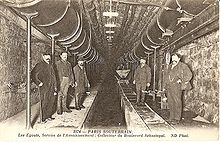Égouts
Égouts ( French égouts , dt. Drains) are called sewer systems in France for the discharge of wastewater .
The 2,400-kilometer-long Parisian sewage network for sewage disposal with its 18,000 maintenance shafts and 26,000 monitoring openings ( Regards ) is famous . It is also an irrigation and drainage system, as it houses the pipes for drinking water and for the service water used, among other things, for street cleaning. It transports over a billion cubic meters of wastewater and rainwater every year and is maintained by around 1,000 sewer workers.
Around 40,000 visitors annually gain an insight into the historical development of the sewer system and water supply in the French capital by visiting the Parisian Egouts .
history
The first égouts of Paris were built around 1350, the first canals to take surface water and divert it into rivers. Before that, the water flowed rather poorly along the streets, collected at the deepest points and formed infectious sewers there.
On the right bank of the Seine there was a canal that flowed in two directions, the Ruisseau de Ménilmontant , which was later called the Grand Égout de Ceinture (large drainage belt). This stream, the incline of which was uneven, originated at the foot of the hill of Belleville , a western slope, followed the foot of the slope and flowed below the rue Gaston-de-Saint-Paul into the Seine , the other took the path to the east and in the trench of the Bastille ; it was later extended to the Seine, where it flowed into the Seine below the Pont d'Austerlitz .
On the left bank of the Seine, the surface waters could flow off in the east into the Bièvre , the Fossés Saint-Bernard (French: Fossés , German trenches) and the Fossés Saint-Victor , in the west into today's Égout Guénégaud , which runs along under the houses. This égout , which is no longer in operation, spilled into the Seine below the Tour de Nesle .
Between 1350 and 1618, other drains were built, especially the one on Rue Montmartre , which was used under Charles VI. († 1422) was bricked and roofed, that of Le Ponceau , who crossed the most densely populated part of the city and merged into the Grand Égout at the Porte du Temple . This égout was partially capped in 1605, as were the égouts of the Rue Vieille du Temple (the Égout Courtille-Barbette ), the Rue Sainte-Catherine , the Rue Saint-Louis and the Rue des Filles-du-Calvaire . Another ditch, which was supposed to receive the sewage from the halls, drained into the égout of Rue Montmartre .
In 1663 the total length of the covered égouts was 2353 meters, that of the open égouts 8035 meters, of which 6218 meters for the égout de Ceinture . Thus, more than 10 kilometers of canals or ditches had been built within three centuries. If you take into account that in the middle of the 17th century the city consumed no more than 1,700 cubic meters of water a day, it becomes clear how little current hygiene issues were at the time.
Towards the end of the 18th century, the length of the covered égouts was 26,051 meters and could only be increased by 11,043 meters by 1824. The total length of 37,094 meters includes open trenches of 1,466 meters.
Web links
- private page Les égouts de Paris (French)

